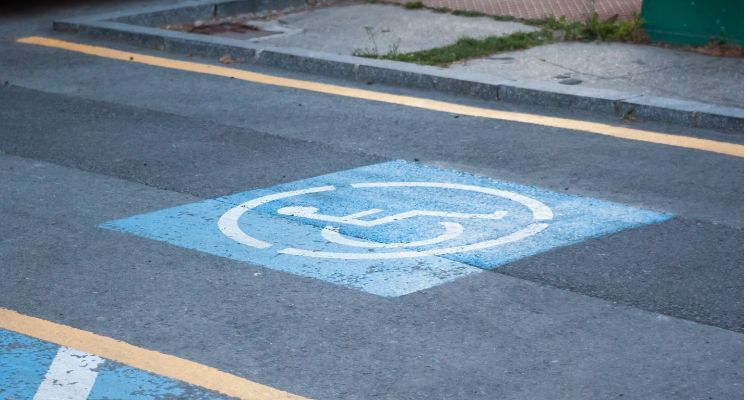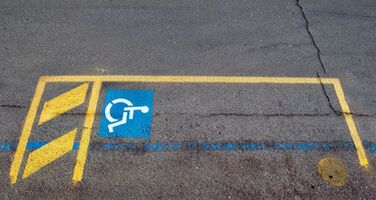
Tips for Making the Most of Your Handicap Placard in Utah
For individuals with mobility impairments, having a disability tag is an invaluable resource. It grants access to designated parking spaces that are closer to building entrances, have more room for getting in and out of vehicles, and make navigating public spaces easier. In UT, disability tags are issued by the Utah Division of Motor Vehicles (DMV) to qualified individuals with physical limitations. These tags offer more than just accessible parking—they provide increased independence and support for individuals facing challenges with mobility.
This article will provide a comprehensive guide to help you make the most of your handicap placard in Utah. From understanding the eligibility requirements and application process to knowing where and how to park, we’ll cover it all. We’ll also look at the rules for proper usage, renewal, and avoiding penalties. Finally, we’ll include some helpful FAQs and a conclusion to ensure you have everything you need to use your disability tag responsibly and efficiently.
Understanding Handicap Placards in Utah
What Is a Disability Tag?
A disability tag, also known as a disability placard or permit, is a special parking tag issued to individuals with disabilities to facilitate their access to public spaces and services. It allows holders to park in designated disabled-accessible spaces closer to building entrances and other key areas. These spaces are typically wider to accommodate vehicles with ramps or lifts and are located near entrances for easier access.
In UT, having a disability tag is crucial for individuals with mobility impairments because it ensures they can more easily access essential services like grocery stores, medical facilities, and government buildings without the physical strain of walking long distances. It also provides metered parking exemptions in many areas, allowing those with disabilities to park without the additional financial burden.
Types of Disability Tags in Utah
UT offers several types of handicap permits to meet the needs of individuals with different levels of disability:
- Permanent Disability Tag: Permanent tags are available for individuals with long-term or permanent mobility impairments. These tags do not need to be recertified every six months but must be renewed every few years (typically every four years).
- Temporary Disability Tag: Temporary tags are issued for individuals with short-term disabilities. They are valid for a maximum of six months, after which they can be renewed if the condition persists. A new medical certification will be required if you need to extend the duration.
- Disability License Plates: If you prefer a more permanent solution, UT also offers disability license plates. These plates are attached to your vehicle and serve the same purpose as a tag. This option is often preferred by individuals who use a personal vehicle exclusively for their transportation.
Who Qualifies for a Disability Tag?
To qualify for a disability tag in UT, an individual must meet specific medical criteria. These include:
- The inability to walk more than 200 feet without stopping to rest.
- Use of portable oxygen.
- Severe lung disease or other respiratory conditions.
- Cardiac conditions classified as Class III or Class IV by the American Heart Association.
- Dependency on mobility aids such as a wheelchair, walker, crutches, or cane.
- Severe neurological, orthopedic, or arthritic conditions that impair mobility.
These conditions must be verified by a licensed healthcare provider, such as a physician, nurse practitioner, or chiropractor, who will certify the individual’s mobility limitations as part of the application process.
Costs Associated with Disability Tags
In UT, disability tags themselves are free of charge, whether you’re applying for a temporary or permanent tag. However, if you choose to apply for a disability license plate, there may be a small administrative fee to cover the cost of issuing the plate. In addition, if you need to replace a lost or damaged tag, the state may charge a nominal fee for the replacement.
How to Apply for a Disability Tag in Utah
Applying for a disability tag in UT is a straightforward process, but it requires some key documents and medical verification. Here’s a breakdown of the steps you’ll need to follow:
Step-by-Step Application Process
- Obtain the Application Form: The first step is to download the “Utah Application for Disability Placard” form from the Utah Division of Motor Vehicles (DMV) website or pick one up from any DMV office.
- Complete the Personal Information Section: Fill out your name, address, driver’s license or state ID number, and vehicle information if applying for a license plate.
- Get Medical Certification: Take the form to your healthcare provider, who will complete the medical certification portion, verifying your disability and whether it’s temporary or permanent.
- Submit the Application: Once the form is completed and signed by both you and your healthcare provider, submit it to the state DMV by mail or in person at any DMV office. Be sure to bring your state-issued ID when submitting the application in person.
Required Documentation
- A completed disability tag application form.
- Certification from a licensed healthcare provider.
- A valid UT driver’s license or state ID.
Tips for Making the Most of Your Handicap Placard in Utah
Having a disability tag offers valuable parking benefits, but there are specific ways to use it properly and maximize its advantages. Here are some key tips for making the most of your Utah disabled permit:
1. Know Where You Can Park with a Disability Tag
Your disability tag allows you to park in designated accessible parking spaces, which are marked with the international symbol of accessibility. These spaces are usually wider than regular parking spaces and located near building entrances, ramps, or elevators.
Additionally, some UT municipalities offer exemptions from parking fees or extended time limits for disability tag holders. Check local regulations to see if these benefits apply in your area.
2. Always Display Your Tag Properly
When you park in an accessible parking space, make sure your disability tag is clearly visible. It should be hung from the rearview mirror with the front of the tag facing outward, showing the permit number and expiration date.
Failure to display the tag properly could result in a parking ticket, even if you are legally allowed to park in the space. Always double-check that your tag is correctly displayed before leaving your vehicle.
3. Be Aware of Parking Time Limits and Fees
While some cities in UT offer exemptions from parking meter fees or extended parking privileges for disability tag holders, not all areas follow this rule. Always check the signage in parking areas to see if time limits or fees apply.
Even if you’re using an accessible parking space, some cities may still require you to pay parking fees or adhere to time limits.
4. Use Your Tag Only When the Holder Is Present
Disability tags are issued to individuals, not vehicles. This means the tag can only be used when the person to whom the tag was issued is present in the vehicle, whether as a driver or passenger. Family members, friends, or caregivers cannot use the tag unless you, the authorized holder, are with them.
Using a disability tag when the rightful owner is not in the vehicle is considered fraudulent use, which can result in fines or revocation of the tag.
5. Make Sure to Renew Your Tag Before It Expires
Disability tags have expiration dates, and it’s important to renew your tag before it expires. Permanent disability tags in UT are valid for five years, while temporary tags are valid for up to six months.
Keep track of your tag’s expiration date and start the renewal process early to avoid any lapses in your parking privileges. You may need to submit updated medical certification for renewal, particularly for temporary disability tags.
6. Take Advantage of State and Federal Privileges
Your UT disability tag is recognized not only within the state but also in all other U.S. states, thanks to the Americans with Disabilities Act (ADA). This means you can use your tag while traveling across the country and park in designated accessible spaces.
Be sure to check the parking regulations in other states or municipalities, as rules regarding parking fees and time limits can vary.
7. Safeguard Your Tag to Prevent Loss or Theft
Disability tags can be valuable, and they are sometimes targeted for theft. To protect your tag:
- Remove the tag when your vehicle is in motion.
- Store the tag securely in your vehicle’s glove compartment or another safe place when not in use.
- Consider using a tag holder to keep it secure while parked.
If your tag is lost or stolen, report it immediately to the state DMV and request a replacement.
8. Understand That Not All Areas Allow Free Parking
While some areas of UT provide free parking to disability tag holders, this is not guaranteed everywhere. Private lots, parking garages, and certain municipalities may still require you to pay for parking, even if you use a disability tag.
Always check the signage when parking in new areas to avoid fines or fees.
9. Know How to Report Abuse or Misuse of Disability Parking Spaces
Unfortunately, abuse of accessible parking spaces is not uncommon. If you see someone using a disability tag or parking in an accessible space without proper authorization, you can report it to local law enforcement or parking enforcement officers.
In UT, improper use of a disability tag can result in fines, and reporting misuse helps protect the integrity of the system and ensures that accessible spaces remain available for those who need them.
10. Educate Others About Proper Use of Disability Tags
If you have family members or caregivers who drive you, make sure they understand the rules and regulations regarding your disability tag. Educate them on proper display, parking rules, and the importance of only using the tag when you are in the vehicle.
Proper use of your disability tag ensures that you avoid fines and maintain access to the parking benefits you rely on.
Where Can You Park with a Disabled Permit in Utah?
Disability tags offer several parking privileges, allowing holders to park in specially designated spaces that offer easier access to public buildings and services.
Public and Private Parking Spaces
In UT, disability tag holders can park in designated handicap-accessible spaces at public venues such as malls, medical facilities, schools, and government buildings. These spaces are typically marked with the wheelchair symbol and are located near entrances for easier access.
Private properties, like apartment complexes or privately owned parking lots, are not required by law to provide handicap spaces unless they fall under specific federal regulations, such as the Americans with Disabilities Act (ADA). It’s a good idea to check with the property manager or building owner to understand their policies on disabled parking.
Time Limits and Metered Parking
One of the key benefits of having a disability tag in UT is the ability to park for extended periods without paying at metered spaces. In most UT cities, disability tag holders are exempt from parking meter fees, but it’s always a good idea to check the local laws for any restrictions on time limits.
Parking on Federal and State-Owned Property
Disability tags issued by the state of UT are generally valid in federal or state-owned parking areas, including national parks, state parks, and public buildings. However, always check for any additional fees or parking regulations specific to the location.
Common Mistakes to Avoid with Your Handicap Placard
Even with the best intentions, some common mistakes can occur when using a handicap placard. Here’s what to avoid to ensure you stay compliant with UT’s regulations:
1. Forgetting to Display the Tag When Parked
One of the most common mistakes is forgetting to hang the disability tag from the rearview mirror when parking in an accessible space. Without the tag properly displayed, you may receive a ticket, even if you are legally allowed to park there. Make it a habit to hang the tag as soon as you park.
2. Leaving the Tag Hanging While Driving
Leaving your disability tag hanging from the rearview mirror while driving is not only a safety hazard, but it’s also against the law. The tag can obstruct your view, increasing the risk of an accident. Always remember to take down the tag before driving.
3. Letting Someone Else Use Your Tag Without You
Disability tags are issued to specific individuals, not vehicles. Letting someone else use your tag without you present is considered fraudulent use. This can result in fines, and in some cases, the DMV may revoke your disability parking privileges.
4. Parking in Non-Designated Accessible Spaces
Not all parking spaces are designated for disability tag holders. Avoid parking in non-designated accessible spaces such as loading zones, fire lanes, or no-parking areas, even if you have a disability tag. These areas are off-limits and can lead to fines or towing.
5. Using an Expired or Invalid Tag
Using an expired disability tag is illegal and can lead to parking violations. Be sure to renew your tag before it expires to avoid any disruptions in your parking privileges. If your tag is damaged or lost, request a replacement as soon as possible.
Frequently Asked Questions (FAQs)
1. How do I apply for a disability tag in UT?
To apply for a disability tag in UT, you need to complete the Application for Disability Placard or License Plates (Form TC-842), which can be found on the state DMV website. You will also need medical certification from a licensed healthcare provider to confirm that you meet the eligibility requirements.
2. Can I use my disability tag in other states?
Yes, your UT disability tag is recognized in all other U.S. states under the Americans with Disabilities Act (ADA). This means you can use your tag to park in designated accessible spaces across the country. Be sure to check local regulations regarding parking fees and time limits.
3. What happens if I lose my disability tag?
If you lose your disability tag, you should contact the state DMV to request a replacement. You may need to complete a new application form and provide proof of your disability. Be sure to report the lost or stolen tag to prevent unauthorized use.
4. Are disability tag holders exempt from parking fees in UT?
In some areas of UT, disability tag holders may be exempt from parking fees or may enjoy extended time limits. However, this varies by municipality. Always check the signage in the area where you are parking to determine if fees apply.
5. What should I do if I see someone abusing a disability parking space?
If you witness someone misusing a disability tag or parking in an accessible space without proper authorization, you can report it to local law enforcement or parking enforcement. Abuse of disability parking spaces can lead to fines for the offender.
6. Can I renew my disability tag online?
Yes, you can renew your disability tag online through the state DMV’s website, as long as your tag is eligible for renewal and you have not moved out of state. If you have a permanent disability tag, renewal is required every five years.
Conclusion
Having a handicap placard in Utah can make navigating public spaces much easier, but it’s important to understand the rules and regulations that come with it. By properly displaying your tag, following local parking rules, and keeping your tag up to date, you can make the most of the benefits offered by this valuable resource.
Remember that disability tags are meant to serve those with genuine mobility impairments, and proper use ensures that accessible parking spaces remain available for those who need them most. With the tips provided in this guide, you’ll be well-equipped to use your disability tag legally and effectively, helping you maintain independence and improve your mobility.
.png)






